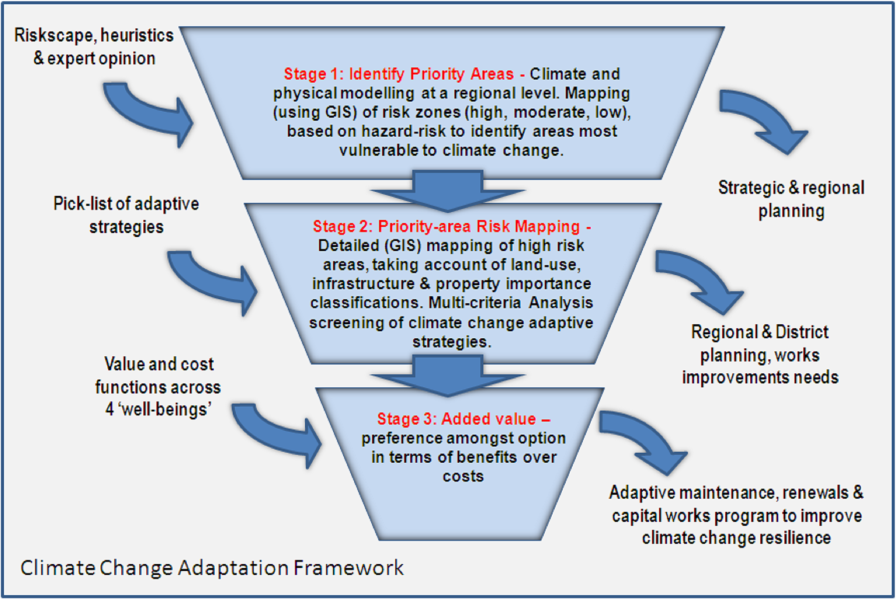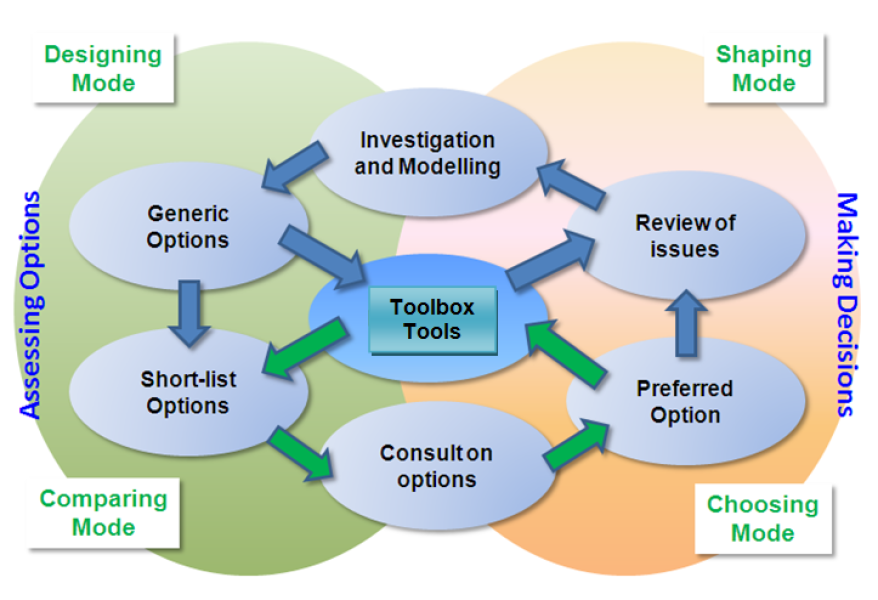A Decision Framework for Climate Change Adaptation
Downloadable version, plus background information on the decision-making process (714 KB)
A decision framework has been developed that provides for a balanced and justifiable prioritisation of sustainable adaptations to climate change and which is flexible to change. The current level of uncertainty surrounding the timing and geographic location of future climate effects requires this framework to be risk-based. It incorporates formal decision-making processes, for the reasons outlined above, and employs a Toolbox approach, because the diversity of decisions to be made is not conducive to a 'one size fits all' approach.
While there are many ways that priorities for action could be established, it is likely that a staged and risk-centred approach, involving a successive narrowing down and refinement of the issues of concern, will be an important part of setting priorities. With climate change singled out for attention, an example three-staged approach is illustrated in Figure 1 on the right.
The stages in Figure 1 may be summarised as follows:
- Stage 1 involves an assessment of priorities across all the climate change effects of relevance for the geographical region of interest. This is to identify priority climate change effects and areas most vulnerable to these effects.
- Stage 2 involves risk mapping of priority (high risk) areas for the selected climate change effects, as identified from Stage 1.
- Stage 3 involves identifying preferences among alternative adaptation schemes to address the priority climate change effect (identified in Stage 1) and the risk identified in the priority locations (identified in Stage 2).
A variety of methods and tools has been provided in the Toolbox to assist establishing priorities at each stage, namely:
- Stage 1: decisions on which climate change effects are of concern and the affected areas of the built environment can be made using the Council Policy and Plan Auditing Tool [Tool 1.5] and the Sensitivity Matrix Prioritisation Tool [Tool 1.6].
Council Policy and Plan Auditing (PDF 411 KB) Sensitivity Matrix (PDF 856 KB)
- Stage 2: decisions on risk mapping of priority areas and interpreting the outcomes can be made using the RiskScape Tool [Tool 3.2], using the Subjective Quantified Risk Assessment Tool [Tool 3.5], or the Multi-criteria Assessment Tool [Tool 4.5].
Using RiskScape (PDF 400 KB) Subjective Quantified Risk Assessment (PDF 860 KB) Multi-Criteria Analysis (PDF 1.6 MB)
- Stage 3: decisions can be made using the Building and Engineering Optioneering Tools [Tools 4.8 & 4.2, respectively], the Multi-criteria Analysis Tool [Tool 4.5], the Top-down Decision Tool [Tool 4.6] or the Standard or Rapid Cost Benefit Analysis Tools [Tools 4.4 & 4.3, respectively].
Building Optioneering (PDF 982 KB) Engineering Optioneering (PDF 1.5 MB) Multi-Criteria Analysis (PDF 1.6 MB) Top-Down Decision (PDF 963 KB) Standard Cost Benefit Analysis (PDF 750 KB) Rapid Cost/Benefit Evaluation (PDF 1.2 MB)
Adding Structure to the Basic Decision Cycle
Figure 2 (on the right) is based on a simplification of the Analysis of Interconnecting Decision Areas (AIDA) methodology. The AIDA process was developed in the 1980s to articulate the key elements of planning decisions, and is just one of many decision frameworks that could be used. It is chosen here because it is consistent with the core requirements of analysis and consultation on options, as promulgated in the Resource Management and Local Government Acts and in MfE guidance.
AIDA has also been selected for the Toolbox because it links the basic three elements of the decision cycle with the practicalities of making decisions on climate change effects that inherently involve uncertainty. For example, mean temperature projections in 50 to 100 years time (MfE, 2008) span the range of very confident (direction of change), through moderate confidence (magnitude of change) to low confidence (spatial/seasonal variations).
In the AIDA process, the "Designing" and "Shaping" modes provide the "Information" in the decision cycle. "Views" in the decision cycle are obtained through the "Comparing" and "Choosing" modes of the AIDA process. The Toolbox tools (centre of hub) provide the means of arriving at a consensus on which solutions are best, given the information available and views expressed.
Figure 2 is cast in the role of assessing climate change adaptation options to derive a preference (priority) amongst alternatives, given limited information and possible conflicting views about what is preferred. However, the same process can be applied at the other stages (see Figure 1) of the decision process.
Thus exchanging the word "Options" used in Figure 2 for the words "Climate Change Effects" makes the above AIDA process diagram relevant to the prioritisation of the effects of greatest concern (Stage 1 in Figure 1). Alternatively, exchanging the word "Options" used in Figure 2 for "Geographical Locations" makes the AIDA process relevant to prioritising and risk mapping the geographical locations of particular concern (Stage 2).
The various Toolbox tools provide a range of principles and methods that can be used to assist the evaluation of priorities, the identification and shortlisting of adaptation options and a means of determining priorities at each the three stages identified in the Framework illustrated in Figure 1.
Toolbox Roadmap Decision-Making Framework
Figure 3 (on the right) provides a generalised 'Roadmap' indicating where the various Toolbox tools may be used in the three stage framework (Figure 1) discussed above.
- In Stage 1, the Sensitivity Matrix [Tool 1.6] may be used, for example, to establish the climate change impacts to urban infrastructure and services that are of most concern.
Sensitivity Matrix (PDF 856 KB)
- In Stage 2, RiskScape [Tool 3.2] and Subjective Quantified Risk Assessment [Tool 3.5] may be used to identify geographical areas were the climate change impacts might be most significant.
Using RiskScape (PDF 400 KB) Subjective Quantified Risk Assessment (PDF 860 KB)
- At Stage 3, Rapid Cost/Benefit Evaluation [Tool 4.3], Multi-Criteria Analysis [Tool 4.5] and the Top-Down Decision Tool [Tools 4.6] may be used to assist in the selection of options.
Rapid Cost/Benefit Evaluation (PDF 1.2 MB) Multi-Criteria Analysis (PDF 1.6 MB) Top-Down Decision (PDF 963 KB)
It is not intended, nor it always necessary, to start at the beginning (Stage 1) of the Roadmap illustrated in Figure 3. In some situations, depending on prior work, it is possible to apply the tools without completing earlier steps. However, there could be a danger that later steps may be compromised as a result. For example, inadequate consideration of alternatives may potentially result in delays in achieving the required consents and substantial re-work.
Figure 3 is used in the various linkage documents included in the Toolbox to provide signposts for the user to understand the next steps that should be taken.
Related links
- Urban Impacts Toolbox
- Climate variability and change
- NZ temperature record
- Climate change scenarios for New Zealand




